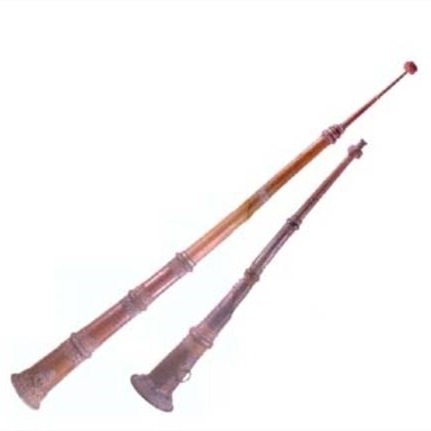Tongqin overview

Tongqin (pinyin: Tongqin), also known as "mang tube", "tongdong", "tongdong", "big copper horn" and so on. It is a Tibetan and Mongolian wind instrument and a very important bass instrument in the Lamaist band. It is popular in lama temples in Tibet, Inner Mongolia, Qinghai, Sichuan, Gansu and other places. It has a history of more than 1,100 years in Tibetan areas.
The Tibetan language "Tongqin" means a large number. The Kang dialect area and Jiarong dialect area are called "Ladong", the Mongolian people are called "Bili" and "Biligu", and the Han people are called "Large tube" and "Changjiao". No.", "Small Copper Horn", etc.
Tongqin is played by trained lamas. When playing, one end of the trumpet is placed on the ground or on a wooden frame, and the player holds the upper end of the instrument with both hands. Tong Qin has his own repertoire. Tong Qin's tone is deep and rich, and it sounds quite solemn and majestic.
The tube body is made of copper and is made of three sockets. The top is thin and the bottom is thick, the thin end is the mouthpiece, and the thick end is in the shape of a trumpet. When playing a total length of about 300 cm, one end of the trumpet mouth is placed on the ground or a wooden frame. The player stands and holds the top of the pipe with both hands. . Can play cones, overtones and minor portamentos. The volume is huge and the tone is muffled. It feels solemn and majestic. Used in religious festivals or religious activities.
- type:wind instrument
- nickname:Mangtong, Tongdong, Tongdong, Big Tongjiao
- incoming time:second half of the 16th century
reference materials and contributors
- 筒钦 · 百度百科
- 筒钦 · 搜狗百科
- 筒钦-中国民族乐器介绍 · 中小学音乐教育网
overview of other similar instruments
- sanyanxiao overview
- Daguangxian overview
- Leiqin overview
- hahao overview
- yandundagu overview
- Han Xiaozheng overview
- Fang Xiang overview
- guanzi overview
- zhuqin (Dao Qin) overview
- zhuiqin overview
- bangzi overview
- three-stringed piano overview
- Gehu overview
- xiao overview
- xiaokonghou overview
- Konghou overview
- Sheng overview
- suona overview
- hulusi overview
- gushao overview
 渝公网安备 50010702504639号
渝公网安备 50010702504639号